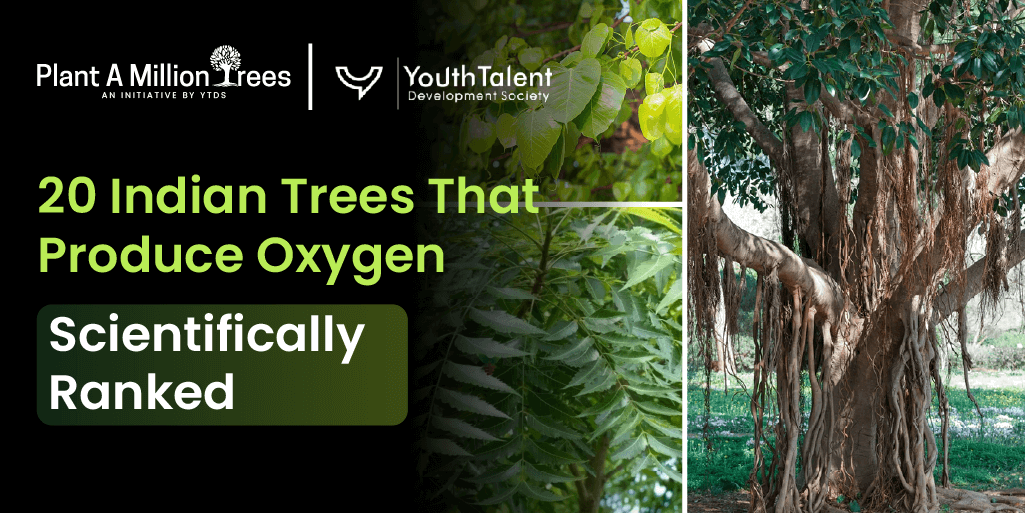India is a country of sunshine, blazing heat, and more and more concrete sceneries. Each year the temperature in...
Because Indian cities and urban areas are filling up quickly, the desire for clean air is higher than at any previous time. Delhi alone is said to have PM2.5 pollution that is around 5 times higher than what is set by the World Health Organization.
Amongst the environmental challenges, trees act as cleaners by producing oxygen and making the air safer for people. In this article, we explain which 20 Indian trees are the best producers of oxygen, so people know why it matters to encourage their planting.
Should you ask which or what tree gives the highest amount of oxygen, keep reading to discover the right answers for you at home or in your community.
How Do Trees Produce Oxygen? The Science Explained
This transformation involves carbon dioxide being magically changed into oxygen through a process called photosynthesis, which needs sunlight. In the day, CO₂ is collected by trees and O₂ is released from the leaf pores.
A tree’s type, leaf area, size, and rate of growth determine its tree oxygen cycle.
In an unusual practice, certain trees use CAM, which means they are able to create oxygen, even during the night, for better overall air quality always.
In this blog, we will find out which trees produce oxygen every hour and the reasons they should be given special attention.
Top 20 Oxygen-Producing Trees in India

1. Peepal Tree (Ficus religiosa)
The Peepal produces oxygen in the worst times too, and it continues to give off oxygen in the air at night. Apart from its positive effects on health, it is seen as sacred in India, which makes people use it throughout public and religious areas.
2. Banyan Tree (Ficus benghalensis)
This tree has many large leaves that give it a champion role in cleaning the air. Because of how wide it is and how long it stays, it offers great worth in parks and urban settings.
3. Neem Tree (Azadirachta indica)
For its strong capacity to oxygenate the air, the Neem helps fight pollution and also keeps pests at bay naturally. You can use it for roadsides or your home garden.
4. Arjuna Tree (Terminalia arjuna)
Arjuna trees help create oxygen and have a positive effect on the heart and blood circulation, making them special. Since the forest is densely leafy, it helps the environment by trapping carbon.
5. Jamun Tree (Syzygium cumini)
Besides giving a lot of oxygen, this tree yields healthy and delicious fruits. It makes local biodiversity better by welcoming birds and bees.
6. Ashoka Tree (Saraca asoca)
Because it’s small, looks neat, and continues to give oxygen in all seasons, Ashoka is perfect for urban planting in apartments, schools, and small parks.
7. Tulsi Plant (Ocimum tenuiflorum)
Even though it is a little plant, Tulsi uses CAM metabolism to give off oxygen at night. It is well-known as an ingredient in cooking and temples plus its many medical benefits.
8. Bael Tree (Aegle marmelos)
Bael tree is able to endure drought and its oxygen cycle is very efficient. Traditional Indian medicine considers Ayurveda to be an important element.
9. Saptaparni (Alstonia scholaris)
Many cities use this tree for their reforestation projects. The quick growth and thick branches of trees are why cities choose them to help clean the air.
10. Indian Almond (Terminalia catappa)
Due to its wide canopy, an Indian Almond tree helps manage the microclimate, so it is particularly valuable for parks and streets in cities.
11. Drumstick Tree (Moringa oleifera)
Drumstick tree grows fast and its leaves contain plenty of nutrients. Also, it has a good oxygen supply, which helps keep the environment and supplies fresh.
12. Palash (Butea monosperma)
Also called Flame of the Forest, Palash is heat resistant and also blunts outside noises. Colorful flowers on the plant help attract and support bees and butterflies.
13. Golden Shower Tree (Cassia fistula)
It is popular in cities for the cheer it brings and the way it helps different pollinator species. It makes a good option for the sides and separation of roads.
14. Indian Coral Tree (Erythrina variegata)
Because it brings many perks to the environment, the tree can attract various types of wildlife and produce lots of oxygen from the sun.
15. Baheda (Terminalia bellirica)
Baheda is respected for creating oxygen and for what it does in Ayurvedic medicine. This tree improves the environment and benefits people’s health.
16. Indian Gooseberry (Phyllanthus emblica)
Not only does Amla produce helpful amounts of oxygen during the night, but its fruit is famous for increasing immunity thanks to its many beneficial vitamins.
17. Gulmohar (Delonix regia)
Because Gulmohar trees are large and spread far, they give plenty of shade and lower temperatures in cities.
18. Amaltas (Cassia fistula)
Many appreciate the Amaltas tree because it has clusters of yellow flowers and it is important for removing pollution in crowded cities.
19. Kadamba (Neolamarckia cadamba)
It is famous for its lovely fragrance and unique ability to boost the oxygen in the city. Banyan is usually planted near public buildings and holy places.
20. Indian Laburnum (Cassia fistula)
Because of its lengthy blooming, this plant resembles CAM flowers, offering oxygen in the day and to some extent at night, which is why it is important in urban environments.
Highlights:
- Peepal Tree is the number one tree in India for producing oxygen. The big canopy and use of CAM mean that it releases oxygen around the clock.
- Besides increasing the air quality, this religious plant is revered in many Indian tradition celebrations.
- Having neem oxygen around can help lower levels of air pollution and eliminate harmful microbes, which explains why it is usually found in city parks.
Which Trees Produce Oxygen at Night? (CAM Trees)
Introduce CAM trees to your environment if you are trying to maintain the best air quality 24 hours a day. Some examples to note are:
1. Peepal Tree is another name for Ficus religiosa.
- CAM is working and releasing oxygen at night.
- Significance of culture encourages people to take part in plantation events.
2. Tulsi also is known as Ocimum tenuiflorum
- People use CAM positive affective material in their homes and temples.
- Your garden looks great when Tulsi is placed together and allow for less space between.
3. Indian Gooseberry (the plant Phyllanthus emblica)
- Continued oxygen release is one of the qualities found in CAM plants during the night.
4. Indian Laburnum (Cassia fistula) contributes partially to CAM therapy.
- An oxygen tree in parks and along roads is very useful.
Best Trees to Improve Air Quality in Urban Spaces
If you want to increase air quality even during the night, opt for trees that have CAM. Some points are:
1. Peepal Tree (Ficus religiosa)
- CAM function is on, and oxygen is let out at night.
- When plantation causes are important to people, it draws more support and assistance from the public.
2. Tulsi (Ocimum tenuiflorum)
- Most homes and temples have adopted CAM positive.
- When, planted close together, shrubs have a greater impact.
3. Indian Gooseberry (Phyllanthus emblica)
- Traits of CAM plants allow them to release oxygen at night too.
- Indian Laburnum (Cassia fistula) (Partial CAM activity)
Jacaranda trees make parks and roadside areas more pleasant with their flowers.
How to Choose the Right Tree for Your Home or Neighborhood
Before choosing a tree to plant in cities, check that it will give high oxygen levels and that it is suitable for city use, takes up the desired space, and isn’t difficult to maintain. Here is a selection of oxygen tree India plants especially suited to urban areas.
- Neem trees are excellent picks for road sides and gardens at home. Since this plant filters the air, needs little water, and keeps pests away, it helps keep busy streets and areas both practical and healthier.
- The Ashoka tree works very well for buildings in cities and apartment complexes. Because of its slender shape and classy look, it does not take up a lot of room and can still provide plenty of oxygen for small outside areas.
- Damaged spaces and small parks look attractive when planted with Saptaparni (Alstonia scholaris). Because it grows so fast and adjusts well, it increases urban biodiversity and gives reliable shade and fresh air.
- School gardens and kitchen gardens are perfect places for the Drumstick tree (Moringa oleifera). The fast pace of its growth along with its nutritious leaves are good for the environment and people’s health, making it an ideal learning topic for young children.
- For projects that focus on beautifying cities and town areas, the Golden Shower tree (Cassia fistula) is an excellent choice. The bright yellow flowers just add to city beauty and at the same time refresh the air around them.
- In addition, Gulmohar (Delonix regia) trees are planted in parks and playgrounds, giving people plenty of shade. The large canopy over cities provides shade and also shelters birds as well as pollinating insects.
When these oxygen releasing trees are strategically added in cities by urban planners and residents, the air becomes cleaner, sidewalks stay cooler, and the environment stays greener.
Maintenance Tips for High-Oxygen Trees
- Pruning on a regular basis helps leaves to grow healthily.
- Give new plants enough water in the early phase of their growth.
- Ensure that roots do not get near important pipes or wires in the area.
More Than Just Oxygen: Other Environmental Benefits of Trees
Continuously planting oxygen releasing trees in India helps our environment in many other important ways than simply cleaning the air.
- Trees such as Banyan, Jamun, and Coral Tree help increase the number of birds, bees, and good insects around your garden.
- Barrier provided by the thick foliage reduces sound pollution along roads and railways. The greenery in cities helps reduce temperatures by about 4–5°C, thanks to Neem, Gulmohar, Peepal trees and several others.
- Intake of Water by Deep Roots helps save groundwater and stops flooding in cities.
For this reason, oxygen trees help balance microclimates and contribute to more sustainability around cities.
Conclusion
India needs people who are willing to protect the environment. Everyone can take part in making the air clean by growing oxygen-emitting trees either indoors or in parks.
Remember:
- Among all trees, Peepal produces the most amount of oxygen.
- Go for CAM trees such as Tulsi, Peepal, and Indian Gooseberry if you want to see an effect for 24 hours.
- Using Neem and Ashoka in urban landscapes is a good choice since they thrive and offer plenty of shade, with little care needed.
Right away, choose to grow an oxygen tree at home, in your school, or in your community, with the Youth Talent Development Society (YTDS). A single tree helps to make a difference. Good breathing health in India is vital for our future.
Frequently Asked Questions About Oxygen Trees in India
What gives out more oxygen in the country of India?
Peepal Tree (Ficus religiosa) is seen as the most oxygen generating tree in India.
Which tree keeps providing oxygen all through the day and night
Trees such as the Peepal Tree, Tulsi, and Indian Gooseberry give out oxygen around the clock because of CAM photosynthesis.
Which tree do people choose to plant for air purification?
- The quality of your air will be best improved if you select the right tree for your location.
- In an urban balcony, you can plant Tulsi or Drumstick.
- Banyan, Peepal, Neem are found in community parks.
- School garden: Golden Showers
What kind of care do these trees require?
- Keep the soil moist at the beginning of the plant’s life.
- Stop animals from eating the young plants.
- Every year, prune developed trees to help them give off more oxygen.




